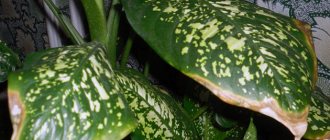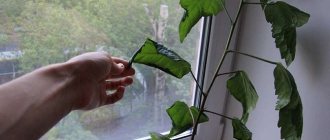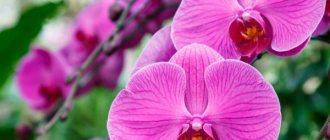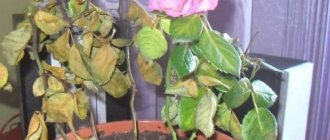Dieffenbachia quickly reacts to changes in conditions by deteriorating its appearance. Its leaves often turn yellow, and sometimes even experienced gardeners cannot confidently name the reason for this.
Indeed, yellowing of leaves is caused by many factors: very bright lighting, excessive watering, changes in temperature and humidity, attack by pests and some others.
In the article you will learn what to do if the leaves of Dieffenbachia turn yellow, and you will also see the reasons why this happens.
Direct sunlight
When direct rays of the sun hit the leaves of Dieffenbachia, yellow-brown burns are formed, which lead to yellowing and drying of the entire leaf.
It should be remembered that Dieffenbachia should not be kept in the sun, but in partial shade .
In summer, the plant should be placed on a south-eastern window, where the sun's rays will hit it only in the morning.
Here the lighting will be sufficient for good growth, but without direct sun. If this is not possible and Dieffenbachia grows on a south-facing window, it must be shaded to avoid burns.
In winter, the flower requires fairly intense lighting. It is better to move it to the most illuminated windowsill. Winter sun rays will not harm the flower; you should not be afraid of direct sun during the cold season.
About precautions
Dieffenbachia is undoubtedly an aesthetically attractive plant. However, one cannot ignore the fact that it can pose a real threat to others if handled carelessly. The poisonous houseplant Dieffenbachia contains substances that cause allergic reactions when directly interacting with the skin or mucous membrane. It leaves burns and ulcers. Dieffenbachia should be kept in places that are difficult for children to reach. Moreover, it is not recommended as a decorative element in preschool institutions.
For animals, contact with the poisonous Dieffenbachia plant is no less dangerous. It has been noticed that cats have an increased interest in it. As in humans, if an animal chews a leaf of a plant, it can both provoke severe poisoning and cause anaphylactic shock.
When in contact with the plant, you should always wear gloves and protect your eyes from possible splashes of poison when pruning.
Strong hydration
Excessive moisture leads to fungal diseases of the plant
Excessive soil moisture easily leads to various fungal diseases. When the roots rot, the leaves of the plant first fall down and then begin to turn yellow. Moreover, the plates throughout the plant turn yellow.
In case of rotting, Dieffenbachia needs an emergency transplant and reduced watering , and sometimes this does not help. We have to cut off and root the surviving tops.
To protect the plant from rotting, it is necessary to strictly adhere to its watering regime. You can’t overwater the flower, but you shouldn’t overdry the earthen ball either, as this can cause the death of the plant. Keeping the soil moist but not wet is quite simple. Watering is carried out only after the top layer of soil in the pot has dried to a depth of 2-3 cm.
Sometimes plants turn yellow as a result of root rot and with the correct watering regime. This happens when the soil composition is incorrectly selected. The soil for Dieffenbachia should be light. In heavy soils, water stagnation and root rot are possible.
Low air humidity
With insufficient watering and low humidity, Dieffenbachia leaves begin to turn yellow from below. First the tips turn yellow, then the entire leaf blade. Such plates dry out and fall off over time. This is often accompanied by loss of color and lightening of the upper leaves.
Often in a city apartment it is difficult to create the necessary air humidity for Dieffenbachia . In summer, the room is quite hot and dry; in winter, during the heating season, the air is dried out greatly by heating radiators. Therefore, for many inexperienced gardeners, Dieffenbachia is a long bare trunk with several leaves at the top.
For a plant to maintain its beauty, regular watering and spraying is not enough. It is useful to place it in a tray with a damp substrate: expanded clay, sand or moss. The substrate will humidify the air near the plant and also help preserve its green mass.
Description of the plant - main characteristics
Dieffenbachia has a fleshy and strong stem on which variegated and large leaves are located. This plant has a distinctive feature in the form of an interesting pattern on the surface of the leaf blades. They have stripes with a blurred outline and small spots of light color.
Dieffenbachia grows well at home, and with quality care it can grow up to 2 meters in height in 3 years. This plant is often used in interior decoration; it is used not only in apartments, but also in public organizations.
Important! You should be aware that the juice of Dieffenbachia tissue is poisonous and can cause burns to the mucous membranes or skin. Contact with the poisonous part is most dangerous for children and animals.
There are 40 varieties of this plant in the world and each of them has distinctive features in color and size:
- Dieffenbachia charming grows up to one and a half meters, its leaf blades are up to 28 cm in length;
- dieffenbachia spotted is distinguished by a dense stem and oval leaf blades with variegated colors;
- Dieffenbachia Leopolda is a low-growing variety with a green stem with blue-red spots, leaves about 30 cm long;
- Dieffenbachia Baumann is distinguished by large leaf blades that grow up to 75 cm in length, they are colored green and covered with light spots;
- Dieffenbachia Oersted has cone-shaped leaves in emerald color with a white stripe in the middle.
All available varieties of Dieffenbachia are beautiful and take root well at home. In order for them to feel comfortable, it is important to create suitable conditions that are close to natural.
Reduced temperature and draft
Dieffenbachia is a heat-loving tropical plant. At low temperatures, Dieffenbachia can drop all its leaves (especially if the temperature drops sharply).
The leaves turn yellow very quickly throughout the plant and fall off, except for the very top ones.
The reaction of Dieffenbachia to a draft is drying out and yellowing of the tips of the leaves. If such symptoms occur, you need to move the plant away from opening windows, otherwise it may turn completely yellow and then lose all its foliage.
Dieffenbachia can also react when kept in an air-conditioned room. If you are near an air conditioner under a stream of cold air, it will certainly shed its leaves and lose its beautiful appearance.
You cannot keep this plant not only under air conditioning, but even away from it, because it does not tolerate temperature changes in such a room very well.
Pest infestation
When attacked by spider mites, yellow spots first appear on the leaves of the plant, which then cover the entire leaf blade.
This pest is easy to detect on the underside of leaves, which can be completely covered with a thin web. Typically, treatment with special chemicals allows you to quickly destroy the pest.
Already yellowed plates cannot be restored . Over time, they dry out and fall off. But eliminating mistakes in plant care will lead to the growth of young, healthy greenery.
Bush varieties will acquire lush shapes and green coloring. It is better to renew old tall plants that have lost their leaves by cutting off and rooting the tops. After this, the new plants need to create optimal conditions for growth and development.
Why do Dieffenbachia leaves turn yellow and dry?
Since the exotic guest is quite capricious, her leaves often turn yellow and dry. This can be caused by both disturbances in the care process and diseases, which are quite common for this particular type of plant. Why do plant leaves turn yellow?
Violation of care rules
Several factors can lead to violation of plant care rules. In the first place is improper watering - it can be either excessively abundant or insufficient. The air in the room where Dieffenbachia is located can be very dry. This also applies to office premises, where the lighting is in most cases artificial, and the flowerpot itself is on the windowsill, where sunlight practically does not penetrate. No matter how strange it may sound, pets may also be involved in violations of plant care. They may chew or scratch the leaves of the flower, but the damage may not be noticeable at first glance. In this way, an infection can be introduced that interferes with the normal development of the plant.
Dieffenbachia diseases and methods of their treatment
Dieffenbachia, like any living creature, can get sick and be affected by infections. Fungal, bacterial and viral diseases can interfere with the normal development of the plant. Leaf spotting, which forms first at the edges of the foliage and then spreads to the entire blade, can be caused by improper room temperature or high humidity. Overwatering and accumulation of liquid in the soil can also cause stains. To avoid such phenomena, it is necessary not only to reconsider the systematicity of irrigation, but also the water itself that is used for these purposes.
Anthractic disease - with a fungal disease, the stems and leaves are affected by small orange spots, which over time merge into one large lesion, leading to complete drying of the leaf. It occurs for the same reasons as regular spotting. Treatment of affected areas of the plant is carried out by spraying Dieffenbachia with fungicides.
Fusarios is an infectious flower disease that affects the roots and basal part of Dieffenbachia. Long orange spots appear on the affected areas, which lead to drying out and death of the plant. The appearance of such an infection is caused by overdried soil and lack of fertilizers. To cure a tree, you need to remove the roots from the pot, rinse it under water and get rid of the contaminated soil. Then spray the roots several times with preparations containing fungicides and transplant the plant into new soil.
How to deal with Dieffenbachia pests (video)
Root rot can also lead to yellowing and drying of leaves. To do this, as in the previous case, it is necessary to dig out the roots and clean them of infection. If the roots are black and have an unpleasant odor, this is a sure sign of disease. It can be caused by overwatering. To treat Dieffenbachia, you need to clean the infected roots, replant it in a new place, treat the soil with a fungicide and reconsider the watering.
Dieffenbachia pests affecting the condition of leaves
Despite the fact that Dieffenbachia is partly a toxic plant, it is also susceptible to attack by pests that damage it and affect the foliar system. The most common parasites include:
- spider mite
- aphid
- mealybug
- scale insect
The methods of control for each type of parasite are the same - it is necessary to thoroughly treat the trunk and leaves of the indoor flower with a soap solution, and then wash it off the surface of the flower with ordinary warm water. After this, you need to treat the Dieffenbachia with a specially prepared insecticide solution. If there are two or more plants in the house, it is necessary to treat the remaining home window inhabitants, since parasites tend to move from one plant to another.
Natural causes
Natural causes can also lead to yellowing of Dieffenbachia leaves. In general, this is a natural process that affects older lower leaves. However, when the first spots and dry areas appear on the leaves, there is no need to rush to get rid of them and cut them off at the root. You need to wait until the leaves are completely dry and begin to fall off. Flower growers claim that pruning leaves causes great harm to the plant.
Other causes of yellowing Dieffenbachia leaves
Let's look at other possible causes of yellow leaves in Dieffenbachia.
Lack of lighting
The leaves of Dieffenbachia can turn yellow not only with excess, but also with insufficient lighting. If you keep the plant in partial shade, it will very soon begin to shed its leaves. First, the lowest leaf blades will turn yellow and fall off, then the flower will lose most of its green mass.
Thus, the reason why the lower leaves of Dieffenbachia turn yellow is lack of lighting.
Very often, leaf fall begins in winter. Due to the small amount of sun and short daylight hours, the plant trunk becomes elongated and exposed, and the leaves fall off. At this time of year, it is better to illuminate the plant with special lamps, lengthening the daylight hours.
Lack of nutrition or excess of minerals in the soil
Dieffenbachia responds very quickly to the amount of nutrients in the soil. When there are not enough of them, it sheds its leaves. This happens in the absence of feeding or in the absence of regular transplants. Therefore, it is necessary to replant even the largest plants, since ordinary soil fertilization is not enough.
Sometimes Dieffenbachia is fed too often and intensively . Excess nutrition can also cause leaves to turn yellow. This plant must be fertilized very carefully; a high concentration of fertilizers will lead to leaf fall and loss of decorative appearance.
Incorrectly selected soil composition
Dieffenbachia is very demanding on the composition of the soil.
The acidity of the soil most affects its appearance. The plant does not tolerate alkaline soils and responds very quickly to the presence of lime in the soil. With such a soil composition, all the leaves of this flower may turn yellow in a short time. To preserve Dieffenbachia, an emergency transplant into soil of a suitable composition will be required.
Diseases
Fungal diseases
Root rot occurs under conditions of constant high soil moisture and abundant watering. First, a slight yellowing appears on the leaves of Dieffenbachia, then they wilt and the flower dies. This means that a fungus has appeared in the root part of the plant, which affects the entire root system.
Leaf spotting begins with infection from other indoor plants and is fueled by excess moisture during watering. At the initial stage, the leaves are covered with brown spots surrounded by an orange border. Very quickly the spots increase in size and destroy all the leaves.
Anthracnose is a consequence of acidification and waterlogging of the soil in a pot, as well as parts of an infected indoor flower that have fallen into the soil. With this disease, the leaves become covered with large black or dark brown spots. Very soon the leaves dry out completely and the Dieffenbachia dies.
Fusarium is a disease that is transmitted to a healthy plant from a sick one through an infected soil mixture or when the flower containers in which they are grown are close. The fungus attacks the root system. “Helps” the development of the disease is an insufficient amount of potassium in the soil and prolonged drying out of the earthen coma.
Recommended preventive measures are the use of a high-quality soil mixture, strict adherence to all rules for the maintenance and care of Dieffenbachia, treatment of the flower with special preparations and solutions at the initial stage and at the first unpleasant symptoms.
Viral diseases
Withering shoots, as well as yellow spots on the leaf part in the form of a circle or ring, are the beginning of a viral disease called bronzing. Dieffenbachia leaves are affected very quickly, but do not fall off, but remain on the shoots in a drooping state.
If Dieffenbachia has stopped growing and developing, and a large number of round spots with a light green center and a dark green border appear on the leaves, then the plant is infected with viral mosaic.
Viral diseases, unfortunately for lovers of indoor plants, cannot be treated. Even in the early stages of detection of the disease, it is recommended to urgently remove the culture so that other representatives of the flora in the room do not become infected.
Dieffenbachia can become infected from a diseased flower while being in close proximity to it. Also, frequent spreaders of viral diseases are pests that easily move from one plant to another (for example, aphids and thrips).
Bacterial diseases
One of the most dangerous diseases that cannot be treated, and from which indoor plants die, is bacteriosis. Methods of infection are from a diseased plant to a healthy one through infected stems, leaves, and soil. To protect healthy indoor flowers, it is necessary to urgently isolate the diseased specimen and destroy it. Signs of the onset of the disease are watery areas of the stems or leaves and the acquisition of a brown or brownish tint in the future.
While there are numerous reasons for the yellowing of Diefenbachia leaves, there is one more reason that should not cause panic or worry among indoor plant lovers. This reason is natural and applies to all plants that have lived to a certain age. The maturation or aging of a fast-growing flower can manifest itself in a slight denudation of the stem and the falling of 1-2 yellow leaves at the bottom of the flower. If this is where the shedding of leaves ends and the “signs of disease” have not spread to other plants in the house, then there is no need to worry.
DIFFENBACHIA CARE AT HOME Dieffenbachia
Watch this video on YouTube
Diseases and pests Useful information










